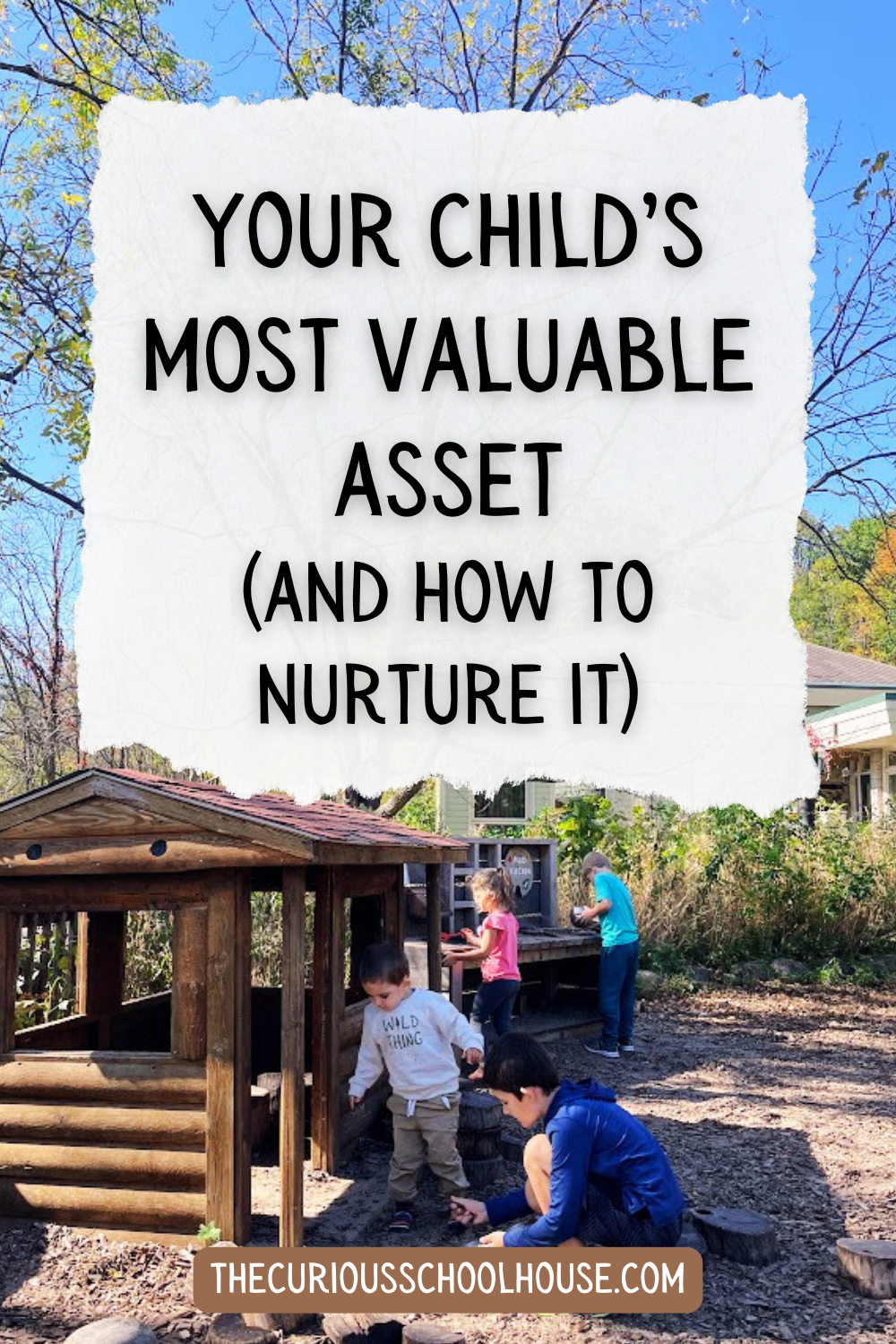Your Child’s Most Valuable Asset (And How to Nurture It)
Did you know that creativity is one of your child’s most valuable assets? Raising creative children should be a priority for every parent in this day and age. Read on to find out why this is, and what to do about it!
“This is boring,” my son complained. “I don’t have anything to do.” He slumped on the bench next to me, pouting and muttering, for a solid twenty minutes, while I ignored him and read my book.
We were spending a sunny fall morning at our local nature center and had arrived at the nature playground, where a simple mud kitchen is nestled next to a miniature wooden cabin, along with a few stumps, rocks, and logs for climbing. Our youngest two immediately ran off to play together, but one of the older boys, who shall remain unnamed, was not impressed. “That’s fine if you’re bored,” I said, “but we’re going to stay here for a bit and let your little siblings play.” The two other older boys also seemed to be at a loss for a while; they wandered around the edge of the playground, stared at the sky, and threw a few pinecones at their sister for good measure.
However, it was a beautiful day, I had a book, and the younger two children were happily working at the mud kitchen, so I was in no hurry to leave. I read a few more pages, and waited.

I’ll share the rest of the story down below, but for now you may be wondering, “What valuable asset could a grumpy and bored child possibly have?” As painful as it can feel to our children, boredom is often the precursor to creative, imaginative, and innovative ideas, and those ideas are the invaluable assets that our children will need, no matter where their future takes them.
I don’t know if you’ve noticed, but the technology around us is changing and evolving at a mind-boggling rate. No matter what field our kids might end up working in during their adult lives, creativity is an essential skill that will set them apart from others in their field! Thankfully, raising creative children is not inherently difficult, because as persons made in the image of a creative God, our children were born with all the imagination and innovation they will ever need.
Most of what is required from us as parents is a nurturing, an encouraging, and a stepping back. I believe this is part of what we see in Jesus’ few instructions regarding children: “Do not hinder” (Matthew 19:14), “do not stumble” (Mark 9:42), “do not offend” (Luke 17:2) – almost as if we grownups can too easily fall into the trap of doing more harm than good in our well-meaning efforts towards children. Could this be true?
Here are some ideas for raising creative children, all of which we have personally tried and had success with in our own home. As always, please take these ideas with a grain of salt, and consider whether they might – or might not – work for your own unique children. Our children are not geniuses, they are far from perfect, but these simple and accessible ideas have borne fruit in our own small lives, and perhaps they will help you too.
7 Ideas for Raising Creative Children
1. DO NOT try to “teach” creativity. I promise you, this will backfire! Think of this less as a skill to be mastered than as a spark to be nurtured. Your child is born with boundless amounts of creativity – in fact, he probably is much more creative than you are. All that we want to do as parents and teachers is to protect, encourage, and nurture this innate creativity. Imagine yourself as a gardener, keeping out the weeds and watering the seeds, but ultimately unable to control or “force” the outcome. The flowers might come up purple, or they might come up pink, and there’s nothing we can do about it!
We tend and pray, we watch and wait, but our children’s personalities and abilities are not of our making. Creativity cannot be, and does not need to be, taught through a curriculum or a webinar or even a well-written blog post; however, it can be stifled, quenched, and choked out through distractions – and that is what we are trying to avoid.
2. Read good books. Could you guess I was going to include this? We love to read, and the benefits of reading are immense. I cannot tell you the number of times I have seen my children drawing, pretending, or acting out something that we read in a book! Reading good books broadens their world, opens their imaginations, and sparks their creativity. Give your the child the gift of a robust imagination, fed and enriched with countless scenes from faraway lands and magical countries. This is not mere frivolity, but a priceless gift that will serve them well their entire lives.
3. Have open-ended art supplies out and available. Now, I am not talking about the little Hobby Lobby kits that include step-by-step instructions so that each and every “art project” turns out exactly the same. These may be useful for teaching children to follow instructions or to master a specific skill (such as cutting/gluing/painting), but they do nothing to encourage your child’s creativity.
Instead, leave your child alone with some yarn, glue bottles, and construction paper, and see what happens! Or wooden popsicles sticks and rubber bands, or empty toilet paper rolls and markers, or whatever random craft supplies you may have lying around. It’s also a great idea to keep basic art supplies on hand so that when inspiration strikes – and it’s always, always at a time when you cannot drop everything and run to the store – you are prepared, and can let your child loose with their imagination. Let me warn you, raising creative children is a messy business, but it is well worth it!

4. Rearrange, reorganize, or clean up a room. I don’t know what it is about this, but every single time I rearrange the furniture or deep clean a child’s room, all five of them swarm to the area like ants to a fallen popsicle and begin some sort of creative play together. There is something about a fresh, clean space that invites creative play. Yes, it can be a bit discouraging to see your freshly-cleaned, newly-rearranged living room immediately turned into a secret-fort-pirate-spaceship, but if your children are bored and can’t seem to find something to do, have them help you clean and then see what happens.
5. Give your child fewer choices. On a related note to point #4, fewer choices almost always results in better, more creative play. Faced with the prospect of playing in a cluttered, messy, overstimulating bedroom stuffed with toys of every imaginable shape and color, most children will simply give up. It’s too overwhelming, too many choices, and they can’t handle it! If your child walks into their bedroom and tells you they have nothing to do, the counter-intuitive answer might be to remove some toys.
I have experienced this first-hand in our home during the last month. We have been packing up and getting rid of unneeded items in preparation for selling our house, and as a result, the only “toy” currently available in our two middle boys’ bedroom is their giant bag of Legos. That’s it! During this time, all five of our kids have been playing with those Legos, happily and contentedly, for hours on end. I’m half tempted to keep the rest of the toys boxed up even after we move and see how long we can go with just Legos.
Boundaries are a great gift to creativity. Imagine being told, “Paint a picture – any size, of anything you like, with whatever paints and brushes and colors you want!” It would take me ages to decide what to do and how to do it! Our children are the same. However, if I am told, “Paint an abstract image on an 8×8 canvas only using blue, green, and purple oil paints,” then suddenly I have an idea and I can move forward. We can seek for a balance here between too-rigid rules that don’t allow for any creativity (aka that Hobby Lobby kit) and a total lack of boundaries that overwhelms a child with too many options.
6. Eliminate or reduce screens. We go through various seasons of “less screen time” and “more screen time” in our home, depending on health and weather and various other circumstances, but I can tell you with absolute certainty that our children play longer, more independently, and more creatively when we are in a season of low (or no) screen time.
It may be hard to believe, but screen-free parenting is actually easier, because once your children realize that screens are not an option, they will be free to create other options on their own. I’ve seen this time and again with our own children; once they can get past the distracting thought that “maybe if we just keep asking, we’ll get to watch a show,” it is like an actual weight is lifted from their minds and their creativity in play increases exponentially.
7. Give your children time. I cannot for the life of me remember which book it was in, but I read somewhere that it often takes children 45 minutes to decide what to play. Forty-five minutes! This means that if we take our kids to the playground, let them run around for 30 minutes, and then leave, they will not have had enough time to truly engage in creative play.
I saw this in action at the nature center that fall morning.
Despite protestations of boredom, I decided to give our kids more time and see what would happen. So, I read another chapter. Grumpy Child kicked his legs and sighed. However, it wasn’t too much longer – I didn’t notice exactly how or when – before all three older boys were drawn into the play of the younger two. I don’t know quite what they were playing (grownup interference tends to spoil imaginative play), but eventually, all five were deeply engrossed in their make-believe story, to the point that no one wanted to leave.
Note this: if we had left at any point in the first hour, this never would have happened. Good things cannot be rushed and creative, imaginative play requires an inconvenient amount of time.

Raising creative children doesn’t require any special resources or large financial commitments. All it asks of us is that we have the courage to step back, to protect the most essential work of their childhood (play), and to feed their imagination with some beautiful stories. These skills of innovation and imagination are the ones our children will need, and we are the ones who can protect and nurture those skills. Give it a try in your own home, and see what happens!
I read this quote recently on Adam Grant’s Instagram page, and couldn’t stop thinking about it.
“The hallmark of expertise is no longer how much you know. It’s how well you synthesize… It’s not enough to collect facts. The future belongs to those who connect the dots.” ~ Adam Grant
It begs the question, “how does one connect the dots?” I would argue that one of the key ways to do this is with the creative, imaginative thinking that comes so naturally to our children! Raising creative children, therefore, is not only a priority for those few who want to raise musicians or artists – this is a character quality that every human needs in order to be a whole person, both now and in the future.








I love all 7 of your tips for raising creative children! I also love that you pointed out that creativity isn’t a skill to be mastered but a spark to be nurtured.
Great reminders!
What a great article! I agree with you 100%!! My sweet husband and I were just talking about how important boredom is for kids to spawn their creativity. Once that threshold is broken, our homeschool kids play outside for hours and hours like magic!
Yes, it does feel magical!! 🙂
Great post, Emily! Wonderful reminders and I feel encouraged to reduce our screen time. Thank you for sharing! 😊
This is such a good post, and so true! A lot can happen with bored kiddos 🙂
Loved your tips! Great post on raising creative kids!😁
Such good ideas! We so often give up too quickly on our kiddos! Thank you for the insight here! Will definitely be something I keep in mind!